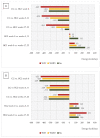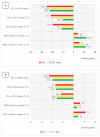Effects of the Malnutrition-Eat Additional Meal (MEAM) Diet on the Serum Levels of Albumin and C-Reactive Protein in Hemodialysis Patients
- PMID: 36558511
- PMCID: PMC9782191
- DOI: 10.3390/nu14245352
Effects of the Malnutrition-Eat Additional Meal (MEAM) Diet on the Serum Levels of Albumin and C-Reactive Protein in Hemodialysis Patients
Abstract
The main objective of this project was to evaluate the efficiency of two kinds of nutritional intervention implemented in hemodialysis patients for 24 weeks (traditional nutritional intervention without a meal served before dialysis for group HG1, and nutritional intervention involving a meal served before dialysis for group HG2), and their impact on nutritional status and serum concentrations of C-reactive protein (CRP). Nutritional status and serum biochemical parameters were analyzed in the control group (CG, n = 70) and in two homogeneous groups of patients, HG1 (n = 35) and HG2 (n = 35). There was an interesting trend in both groups of patients connected with increased intake, mainly of energy and protein. In HG1, the greatest increase in energy intake was observed on Sundays, and in HG2 on the days with dialysis. In HG2, after 24 weeks of the nutritional intervention, an increase in serum albumin (p = 0.0157) and a decrease in CRP concentration (p = 0.0306) were observed, whereas in HG1 there was a decrease in serum albumin concentration (p = 0.0043) with no significant change in CRP concentration. The nutritional intervention applied, called the Malnutrition-Eat Additional Meal (MEAM) diet with an easily digestible meal served before dialysis, was aimed at improving the patients' nutritional status and the obtained results indicate the need not only for substantial reeducation of hemodialysis patients in the area of their diet, but also for undertaking further research and discussions on the possibility of ensuring adequate meals for hemodialysis patients before the dialysis procedure.
Keywords: dietary intervention; inflammation; nutritional status.
Conflict of interest statement
The authors declare no conflict of interest.
Figures





References
-
- Johansen K.L., Chertow G.M., Gilbertson D.T., Herzog C.A., Ishani A., Israni A.K., Ku E., Li S., Li S., Liu J., et al. US Renal Data System 2021 Annual Data Report: Epidemiology of Kidney Disease in the United States. Am. J. Kidney Dis. 2022;79:A8–A12. doi: 10.1053/j.ajkd.2022.02.001. - DOI - PMC - PubMed
MeSH terms
Substances
Grants and funding
LinkOut - more resources
Full Text Sources
Medical
Research Materials
Miscellaneous

